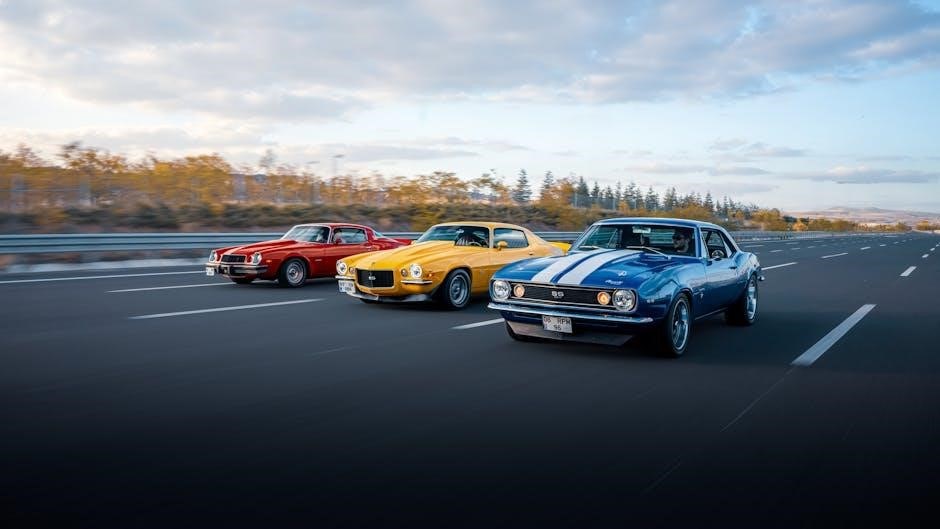The 3-speed manual transmission, produced by Chevrolet, was widely used in passenger cars and trucks from the 1950s to the 1970s. Known for its simplicity and durability, it offered smooth shifting and fuel efficiency, making it a popular choice for both daily driving and highway cruising. This transmission played a significant role in Chevrolet’s lineup, particularly in iconic models like the Bel Air and Chevelle, before being gradually replaced by 4-speed and automatic options. Enthusiasts still appreciate its mechanical charm and historical significance.
1.1 Overview of the Transmission
The 3-speed manual transmission, produced by Chevrolet, was a reliable and durable gearbox used in various vehicles. Manufactured by Muncie and Saginaw, it featured both wide- and narrow-ratio configurations, catering to different driving needs. The transmission was known for its simplicity, with fully synchronized gears in later models, enhancing shifting smoothness. Popular in passenger cars and trucks, it offered a balance of performance and fuel efficiency. Enthusiasts often praise its mechanical appeal and versatility, making it a cherished component in classic Chevrolet models.
1.2 Historical Context and Usage
The 3-speed manual transmission was a cornerstone of Chevrolet’s drivetrain offerings from the 1950s to the 1970s. Initially used in passenger cars like the Bel Air and Chevelle, it later found its way into trucks, showcasing its versatility. The transmission’s popularity peaked in the mid-1960s, with Saginaw becoming the dominant manufacturer. Its widespread use declined as 4-speed and automatic transmissions gained favor, yet it remains a nostalgic favorite among classic car enthusiasts, symbolizing a simpler era of automotive engineering and driving experience.

Types of 3-Speed Manual Transmissions Used in Chevy Vehicles
Chevrolet utilized three primary 3-speed manual transmissions: the Muncie SM318, Muncie SM319, and Saginaw. Each offered distinct features, with Saginaw being fully synchronized and widely used from the mid-1960s to late 1970s.
2.1 Muncie SM318 Transmission
The Muncie SM318 transmission, produced from 1954 to 1969, was a versatile 3-speed manual unit used in both passenger cars and trucks. It featured wide and narrow-ratio configurations, making it suitable for various applications. Known for its durability, the SM318 was commonly paired with Chevrolet’s iconic models like the Chevelle and Bel Air. Its design included a 4-bolt side cover, and while it lacked synchronization in first gear, it remained a reliable choice for drivers seeking a straightforward manual shifting experience.
The SM318 was eventually phased out in favor of the Muncie SM319 and Saginaw transmissions, which offered improved features like full synchronization. Despite this, the SM318 remains a sought-after piece for classic car enthusiasts due to its historical significance and compatibility with older Chevrolet engines.
2.2 Muncie SM319 Transmission
The Muncie SM319 transmission was a 3-speed manual unit used in Chevrolet and GMC vehicles, primarily during the mid-1960s to late 1970s. Known for its durability and smooth operation, the SM319 featured a fully synchronized design, making it more refined than its predecessor, the SM318. It was commonly used in passenger cars and trucks, offering reliable performance for both urban and highway driving. The SM319 was eventually replaced by more advanced transmissions but remains popular among classic car enthusiasts for its simplicity and mechanical charm.
2.3 Saginaw 3-Speed Transmission
The Saginaw 3-Speed Transmission, manufactured by General Motors, was a widely used 3-speed manual gearbox in Chevrolet vehicles from the mid-1960s to the late 1970s. Known for its fully synchronized design, it offered smooth gear engagement and reliability. The Saginaw was installed in various models, including passenger cars and trucks, and was appreciated for its durability and ease of maintenance. It featured different gear ratio options, such as the “no-line” and “three-line” configurations, catering to diverse driving needs. Over time, it was phased out in favor of more modern transmissions.

Applications of the 3-Speed Manual Transmission
The 3-speed manual transmission was widely used in Chevrolet passenger cars, such as the Chevelle and Bel Air, as well as in various truck models from the 1950s to the 1970s, offering a reliable and affordable drivetrain solution for both everyday driving and work applications.
3.1 Passenger Cars
The 3-speed manual transmission was a staple in Chevrolet passenger cars from the 1950s to the 1970s, including iconic models like the Bel Air, Chevelle, and Impala. Known for its reliability and smooth shifting, it was often paired with inline-six and small V8 engines, offering a balance of performance and fuel efficiency. This transmission was particularly popular in base model cars, providing drivers with a cost-effective and straightforward driving experience. Its simplicity made it a favorite for everyday commuting and highway cruising during its era.
3.2 Truck Applications
The 3-speed manual transmission was widely used in Chevrolet trucks, particularly from the mid-1960s to the late 1970s. It was standard in models like the Chevrolet 10 Pickup, often paired with inline-six and small V8 engines. Known for its durability and simplicity, the Saginaw 3-speed was a common choice for work-oriented trucks, offering smooth shifting and reliability. Its compact design and ease of maintenance made it ideal for both on-road and light off-road use, catering to practical needs rather than high performance.
3.3 Specific Models (Chevelle, Bel Air, etc.)
The 3-speed manual transmission was featured in iconic Chevrolet models such as the Bel Air and Chevelle. In the 1957 Bel Air, it paired with the 283 V8, offering a classic driving experience. The Chevelle, from 1964 to 1972, often came with this transmission, except in high-performance trims. These models showcased the transmission’s versatility, blending everyday practicality with nostalgic charm, making it a memorable part of Chevrolet’s heritage for both collectors and enthusiasts seeking a traditional driving feel.

Technical Specifications
The 3-speed Chevy manual transmission features gear ratios varying by model, with options like 2.85, 1.68, and 1.00 for first, second, and third gears. Synchronization improves shifting smoothness, while overdrive configurations enhance highway efficiency. These specifications ensure optimal performance across different driving conditions, balancing power delivery and fuel economy effectively.
4.1 Gear Ratios
The 3-speed Chevy manual transmission offers varying gear ratios, including 2.85, 1.68, and 1.00 for first, second, and third gears. These ratios provide smooth acceleration, optimal power delivery, and efficient highway cruising. Models like the Saginaw 3-speed feature configurations with or without overdrive, further enhancing performance. The wide-range ratios cater to both city driving and long-distance travel, ensuring a balanced and responsive driving experience across different vehicle applications and engine setups.
4.2 Synchronized vs. Non-Synchronized
Chevy’s 3-speed manual transmissions were available in both synchronized and non-synchronized versions. Synchronized transmissions, like the Saginaw 3-speed, offered smoother gear engagement and easier shifting, especially in stop-and-go traffic. Non-synchronized models, such as the Muncie SM318 and SM319, required double-clutching and were more common in early models and truck applications. The synchronized design became standard in later years, improving driver comfort and usability across various vehicle types and driving conditions.
4.3 Overdrive Options
Chevy’s 3-speed manual transmissions occasionally featured overdrive options, enhancing fuel efficiency and cruising comfort. The Muncie SM319, for instance, included an overdrive gear, allowing for lower engine RPM at higher speeds. This feature was particularly beneficial for highway driving, improving mileage and reducing engine strain. Overdrive-equipped transmissions were longer than standard units, sometimes requiring driveshaft modifications. Despite their advantages, these models were less common and eventually gave way to 4-speed and automatic transmissions in later Chevrolet vehicles, marking a shift toward modern drivetrain technologies and driver preferences.
Identification and Distinction
Identifying a 3-speed Chevy manual transmission involves examining physical traits like bolt patterns, part numbers, and manufacturer logos. Muncie and Saginaw units differ in casting marks and gear ratios, aiding distinction and verification for enthusiasts and restorers.
5.1 Physical Characteristics
The 3-speed Chevy manual transmission can be identified by its distinct physical features. Muncie units often have a 4-bolt side cover, while Saginaw transmissions feature a 9-bolt design. The gear ratios and casing marks vary, with Muncie models typically displaying deeper casting numbers. The presence of an overdrive unit or a “granny gear” also differentiates certain variants. Physical traits like the bellhousing bolt pattern and the location of the reverse light switch further aid in identifying and distinguishing these transmissions from other models.
5.2 Part Numbers and Manufacturing Variations
Identifying a 3-speed Chevy manual transmission involves checking its part numbers and manufacturing variations. Muncie SM318 and SM319 units have distinct part numbers, such as 3831705 for the SM318 and 3831706 for the SM319. Saginaw transmissions also have unique identifiers. Manufacturing variations include differences in gear ratios, with Muncie offering both wide and narrow ratios, while Saginaw units feature configurations like 1-Line or 2-Line setups. These variations were designed for specific applications, ensuring compatibility with various engines and drivetrain setups.

Maintenance and Servicing
Regular servicing involves checking and changing the gear oil, typically 80-90 weight, with a capacity of around 3 pints. Draining is done by removing the bottom bolt and copper washer, then refilling after replacement. Ensuring no leaks and following proper procedures is crucial for longevity and performance, especially in preserving these historic transmissions used in classic Chevy models like the Chevelle and Bel Air.
6.1 Fluid Type and Capacity
The 3-speed Chevy manual transmission typically requires 80-90 weight gear oil for optimal performance. The fluid capacity is approximately 3 pints, depending on the transmission model. It’s essential to use the correct viscosity to ensure proper lubrication and prevent wear. The fluid level should be checked by locating the fill plug on the side of the transmission case. Overfilling can lead to leaks and degraded performance, so it’s crucial to follow the recommended capacity strictly. Regular fluid changes help maintain the transmission’s longevity and smooth operation, especially in classic Chevy models like the Bel Air and Chevelle.
6.2 Draining and Refilling Procedures
To drain the 3-speed Chevy manual transmission, warm it up by driving the vehicle to ensure the fluid flows freely. Locate the drain plug at the bottom of the transmission pan and remove it using a socket wrench. Allow the fluid to drain completely before replacing the plug with a new gasket to prevent leaks. Refill with approximately 3 pints of 80-90 weight gear oil through the fill plug on the side of the transmission. Avoid overfilling, as this can cause damage. Always check the fluid level with the car on a level surface and ensure no leaks are present after refilling.

Common Issues and Repair
Leaks from seals and gaskets are common, requiring replacement. Gear engagement problems often stem from worn synchronizers or clutch issues. Regular inspection and part replacement can resolve these concerns effectively.
7.1 Leaks and Sealing
Leaks in the 3-speed Chevy manual transmission often occur from the front seal or pan gasket. These issues can be identified by oil spots beneath the vehicle. To address this, the transmission must be disassembled to replace the faulty seals or gasket. Proper resealing requires clean surfaces and the correct torque specifications. Using high-quality gaskets and sealants ensures long-term reliability. Regular inspection of these components during maintenance can prevent leaks from developing into major repairs.
7.2 Gear Engagement Problems
Gear engagement issues in the 3-speed Chevy manual transmission often stem from worn synchronizers or faulty linkages. Misaligned shift forks or damaged bearings can also cause gears to engage improperly. Symptoms include grinding noises, difficulty shifting, or gears slipping out. To resolve this, the transmission must be disassembled for inspection. Replacing worn components, such as synchronizer rings or bearings, typically corrects the issue. Proper adjustment of the shift linkage and clutch operation is crucial for smooth engagement and optimal performance.

Restoration and Rebuilding
Restoring a 3-speed Chevy manual transmission involves disassembly, inspection, and replacing worn bearings, seals, and gaskets. Expertise and specialized tools are essential for precise reassembly and optimal performance.
8.1 Disassembly Process
Disassembling a 3-speed Chevy manual transmission begins with removing the side cover and internal components. Special tools are needed for bearings and gears. Proper workspace and organization are crucial to avoid losing small parts. Draining the old fluid is essential before disassembly. Each part should be inspected for wear. Cleaning and cataloging components ensures a smooth rebuild. Expertise or detailed guides are recommended for this intricate process to maintain functionality and integrity.
8.2 Parts Availability and Compatibility
Parts for the 3-speed Chevy manual transmission are widely available, with many aftermarket suppliers offering bearings, seals, and gear kits. Compatibility varies by model year and transmission type, so verifying part numbers is crucial. Early models (1955-1964) have distinct variations, while later units share more common components. USA Standard and other manufacturers provide reliable rebuild kits. Ensuring compatibility before purchase is essential to avoid fitting issues, especially between Saginaw and Muncie transmissions. Always verify specifications for a seamless restoration.

Historical Evolution
The 3-speed Chevy manual transmission evolved significantly from its introduction in the 1950s, with Muncie and Saginaw variants dominating through the 1960s and 1970s before transitioning to 4-speed and automatic options.
9.1 Early Models (1950s-1960s)
The 3-speed manual transmission debuted in Chevrolet vehicles during the 1950s, with the Muncie SM318 introduced in 1954 for both passenger cars and trucks. Early models featured non-synchronized first gears, while later versions, like the Saginaw, incorporated full synchronization by the mid-1960s. These transmissions were known for their durability and simplicity, becoming a staple in iconic models such as the Bel Air and early Chevelles. By the late 1960s, the 3-speed began to be phased out in favor of 4-speed and automatic options.
9.2 Transition to 4-Speed and Automatic Transmissions
By the late 1960s and early 1970s, Chevrolet began phasing out the 3-speed manual in favor of 4-speed manual and automatic transmissions. This shift was driven by consumer demand for smoother acceleration and better performance. The 4-speed Muncie, known for its strength and versatility, became popular in high-performance models like the Chevelle SS. Automatic transmissions, such as the TH400, offered convenience and ease of use, catering to a broader audience. This transition marked the decline of the 3-speed in Chevrolet’s lineup.

Driving Experience
The 3-speed manual offered smooth shifting and simplicity, appealing to drivers seeking a straightforward, engaging experience. Its mechanical charm and fuel efficiency made it ideal for both daily driving and classic cruisers.
10.1 Performance Characteristics
The 3-speed manual transmission provided a balance of performance and efficiency, with smooth gear engagement and stable acceleration. Its mechanical simplicity ensured reliability, while the synchronized gears improved shifting ease. Early models were optimized for city driving, while later versions, like the Saginaw, featured improved gear ratios for better highway performance. The lack of overdrive in some units limited top-end speed, but the transmission’s lightweight design and direct connection to the engine enhanced overall driving responsiveness and control.
10.2 Fuel Efficiency and Highway Cruising
The 3-speed manual transmission offered decent fuel efficiency, especially in city driving, due to its straightforward design and lower weight. However, highway cruising was less optimal in non-overdrive models, as higher engine RPMs were required to maintain speed. The Muncie SM319, with its overdrive option, provided better fuel economy and smoother cruising at higher speeds. Even without overdrive, the transmission’s simplicity made it reliable for long-distance travel, though modern drivers might find it less efficient compared to contemporary options.

Modern Relevance
The 3-speed Chevy manual transmission remains popular among collectors and enthusiasts for its simplicity, durability, and nostalgic driving experience, offering a unique connection to classic automotive heritage.
11.1 Popularity Among Enthusiasts
The 3-speed Chevy manual transmission remains a favorite among classic car enthusiasts due to its nostalgic appeal and straightforward design. Many collectors and restorers prefer these transmissions for their simplicity, reliability, and historical significance. Enthusiasts often seek out these units for restoration projects, valuing their mechanical charm and the driving experience they provide. The transmission’s durability and ease of maintenance also make it a popular choice for those aiming to preserve the authenticity of their classic Chevrolet vehicles.
11.2 Comparison to Modern Transmissions
The 3-speed Chevy manual transmission differs significantly from modern transmissions, which offer more gears, advanced electronics, and improved efficiency. Modern transmissions provide smoother acceleration, better fuel economy, and reduced driver effort, especially in traffic. However, the simplicity and mechanical feel of the 3-speed remain appealing to enthusiasts who value traditional driving experiences. While modern transmissions excel in performance and convenience, the 3-speed holds nostalgic charm, embodying an era of straightforward automotive design.
